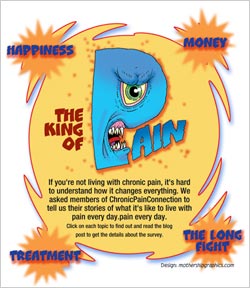To craft the strongest, most targeted pitch, you have to understand your audience’s world view. This means going beyond the numbers to understand a person’s daily life. What is it like
to travel with diabetes? How does your daily life change if you’re living with chronic pain?
To do this, you have to stop relying on PowerPoint as your main source of insight. Over the
last few years of doing research, I have created many decks with lots of graphs. I know a few people have opened them and digested the information. However, there is a lot more to learn from audience
research data and the people providing this data are more than just demographical groups.
This year, I used the power of words and pictures to enrich my understanding of three groups of people
in the health audience: people living with chronic pain, Asperger’s and dementia. I’ll explain how to use these tools to go beyond graphs and percentages and to give more impact in your
audience insight work.
advertisement
advertisement
Losing work, sex, church and everything to chronic pain
Earlier this year, the Institute of Medicine released an extensive report on chronic pain.
“Epidemic” was often used to describe the problem and people seemed surprised to discover that back pain, endometriosis, neuropathy and other types of chronic pain suffered by 116
million adults cost $635 billion each year in medical treatment and lost productivity.
The report was good but the human element was buried in Part C of the Appendix, right before the
Committee and Staff Biographies. The “Summary of Written Public Testimony” had a few comments that came directly from people and pointed out the difficulties of getting a correct
diagnosis, paying for treatment and being taken seriously by health care providers.
I wanted our chronic pain research to put these personal stories front and center.

I worked
with a colleague at HealthCentral and a graphic artist to turn the numbers into a story. The artist, Mike Covington of mothershipgraphics.com, was suffering from back pain when we were working on this
project, providing some unwanted – if helpful – inspiration and insight.
If you click on “Money” in the graphic above, you’ll see this:

We also asked readers what makes a site trustworthy. I used the open text answers to create this word cloud.

Fiction also offers audience
understanding
Another way to learn about your audience is to pick up a book. Two novels I read this summer helped me understand how people with Asperger’s and dementia
experience the world. The Kitchen Daughter and The Last Days of Ptolemy Gray are both well-written and engaging.
Reading these novels didn’t feel a bit like work.
In The Kitchen Daughter by Jael McHenry, Ginny Selvaggio has Asperger’s but has never been formally diagnosed. Her experiences
throughout the book explain how she understands the world and how she calms her panic attacks.
In the first scene the author plunges you into Ginny’s world and her reaction to a crowd of
relatives.
"I open my eyes just a sliver. ... I see Auntie Connie's yeast colored shoes. I smell her beerlike smell. Then too late I see her fingers, reaching.
“Contact.
“When someone touches me wrong it isn't a feeling. It isn't hate or fear or pain. It is just blackness and a chant in me: get/out/get/out/get/out.
"I push past Connie, I can feel bone
under the flesh of her shoulder like the shank end of a ham…I have to get out, but they're all in my way. I shove through. I feel over-hot skin, clammy fish-flesh skin, damp chicken-liver skin,
they're all around me.”
The main character in The Last
Days of Ptolemy Gray by Walter Mosley gave me an idea about how frustrating and paralyzing dementia must be. Ptolemy knows he needs to solve one last problem before he dies, but his mental
confusion is making this impossible.
“So his memory became like secret held away from his own mind. But these secrets were noisy things; they babbled and muttered behind the door,
and so if he listened closely he might catch a snatch of something he once knew well.”
If you don’t have the budget for research or the desire to read fiction, check out Travels with Pain. Liz Hamill blogs about her travels around the world while coping with chronic pain and a bladder disorder.
Use a new tactic for your
2012 audience research. Ask fewer questions and make more of them open ended. Look for personal stories about why people don’t refill their prescriptions or what kind of information they need to
work more successfully with their doctor.
Moving beyond graphs and percentages will help you create messages and products that truly connect with your customers and their needs.